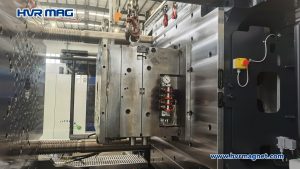
Magnetic quick mold change systems have revolutionized the injection molding industry by significantly reducing mold change times and improving productivity. However, one of the critical factors in ensuring the system’s efficiency and longevity is the correct calculation of clamping tonnage of magnetic platen.
Key Factors in Magnetic Platen Tonnage Calculation
To calculate the total suction force required for a magnetic quick mold change system, several factors must be considered:
- Model Size: The type and number of magnetic poles in contact with the mold play a crucial role. Different models have varying strengths and characteristics, impacting the overall suction force.
- Condition of the Contact Surface: The surface condition of the mold where it contacts the magnetic poles affects the suction force. Smooth and clean surfaces provide better adhesion compared to rough or contaminated ones.
- Material of the Mold: The material of the mold affects its interaction with the magnetic poles. For example, ferrous materials have different magnetic properties compared to non-ferrous ones.
- Thickness of the Mold: The thickness of the mold must meet the required specifications. The suction force calculation is adjusted based on whether the mold thickness is adequate.

Impact of Excessive Clamping Tonnage on Magnetic Platen
Can using a higher clamping tonnage than necessary lead to unnecessary wear and tear on your injection molding machine, ultimately costing you more in maintenance and repairs in the long run?
Yes. Here’s why:
1. Increased Wear and Tear: Excessive clamping force puts additional stress on both the magnetic quick mold change system and the injection molding machine. Over time, this can lead to accelerated wear and tear on components, potentially resulting in more frequent maintenance and repairs.
- Higher Operational Costs: The increased stress on the system may lead to more frequent breakdowns and repairs, raising overall operational costs. Regular maintenance is required to manage the extra load, which can be costly and time-consuming.
- Potential Safety Concerns: Excessive clamping force can also pose safety risks, including the potential for damage to the mold or the machine itself. Proper calibration and adherence to recommended tonnage guidelines help ensure safe and effective operation.
Conclusion
In conclusion, while it might seem beneficial to use a higher clamping tonnage to ensure a secure mold hold, doing so can lead to unnecessary wear and tear on your injection molding machine. This can ultimately result in higher maintenance and repair costs. It is crucial to calculate and use the appropriate clamping tonnage for your magnetic quick mold change system to optimize performance, reduce operational costs, and ensure long-term reliability.






